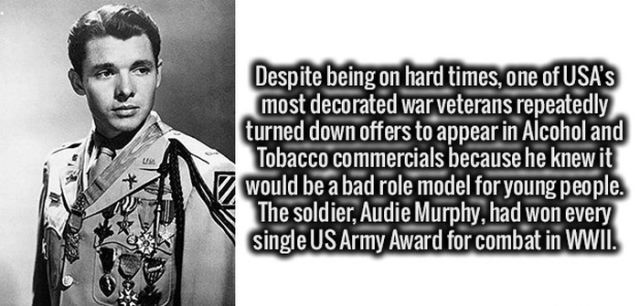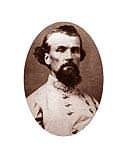
Killed in a plane crash on Memorial Day. How fitting.
Omar Bradley said, “Previous combat had taught us that casualties are lumped primarily in the rifle platoons. For here are concentrated the handful of troops who must advance under enemy fire. It is upon them that the burden of war falls with greater risk and with less likelihood of survival than any other of the combat arms. An infantry division of WW II consisted of 81 rifle platoons, each with a combat strength of approximately 40 men. Altogether those 81 assault units comprised but 3,240 men in a division of 14,000…..Prior to invasion we had estimated that the infantry would incur 70 percent of the losses of our combat forces. By August we had boosted that figure to 83 percent on the basis of our experience in the Normandy hedgerows.”
Nearly a third of the 65 divisions in the Pacific and European theaters suffered 100% or more casualties. However, their regimental staffs saw frontline units obliterated three to six times over. To deal with this problem there were never enough infantrymen coming from the states. Replacement centers continually reassigned artillerymen, machine gunners, cooks, and clerks to infantry duties. The situation in Europe became so severe that rear area units in France and Great Britain were tasked to supply soldiers for retraining as infantrymen. Those suffering battle fatigue came off the line for a few days for clean uniforms, bathing, hot food, and sleep. However, scarcity compelled their repeated return until crippling wounds, mental breakage, death, or victory brought final relief.
For example the 4th and 29th Infantry landed on D-Day and suffered about 500% battle casualties in their rifle platoons during the eleven months until VE-Day. Added to these numbers were half again as many non-battle human wrecks debilitated by trench foot, frost bite, pneumonia, hernia, heart disease, arthritis, etc. Many never returned to duty. In the jungles of the Pacific, non-combat losses often exacted a greater price. But somehow the infantry crossed Europe and the Pacific and always remained in the forefront of attacks.
Ernie Pyle said of them, “The worst experience of all is just the accumulated blur, and the hurting vagueness of being too long in the lines, the everlasting alertness, the noise and fear, the cell-by-cell exhaustion, the thinning of the surrounding ranks as day follows nameless day. And the constant march into the eternity of one’s own small quota of chances for survival. Those are the things that hurt and destroy. But they went back to them because they were good soldiers and they had a duty they could not define.”
Partial bibliography: A Soldier’s Story by Omar N. Bradley
Brave Men by Ernie Pyle (the quote named Tommy Clayton, but was generalized here because Ernie Pyle saw him as an example of the infantrymen he loved.)
Crusade in Europe by Dwight D. Eisenhower The U.S. Infantryman in World War II by Robert S. Rush Foot Soldier by Roscoe C. Blunt, Jr. Links for Listings of United States Divisions during WW II http://en.wikipedia.org/wiki/List_of_United_States_Army_divisions_during_World_War_II http://www.historyshots.com/usarmy/
Army Battle Casualties and Non-battle Deaths in World War II http://www.ibiblio.org/hyperwar/USA/ref/Casualties/index.html
3rd 'Marne' Infantry Division http://www.custermen.com/ItalyWW2/Units/Division3.htm Total casualties greater than 34,000
National 4th Infantry (IVY) Division Association http://www.4thinfantry.org/content/division-history Total casualties of 34,000
29th Infantry Division http://en.wikipedia.org/wiki/29th_Infantry_Division_(United_States)
45th Infantry Division http://en.wikipedia.org/wiki/45th_Infantry_Division_(United_States)
Remembering the Thunderbirds – Oklahoma’s 45th Infantry Division http://www.baptistmessenger.com/remembering-the-thunderbirds-oklahomas-45th-infantry-division/ Total casualties of 62,640 When Gen. George S. Patton described the 45th Infantry Division, he said it was “one of the finest, if not the finest infantry division in this history of modern warfare.”

Killed in a plane crash on Memorial Day. How fitting.
So when he says those ultra-liberal things, I give him a complete pass. Yeah, I think he's earned the right to say whatever he wants.
Excellent read.
Thank you.
Sometime after the end of World War II and Korea, the Army decided to award a Bronze Star to all infantrymen who had been awarded the Combat Infantryman Badge. This recognition was probably appropriate in view of the attrition mentioned in this thread. However, other branches later jumped on the bandwagon and we later found personnel and supply clerks with Bronze Stars for Meritorious Service for routine duty on a safe and well appointed base. Officers expected a Bronze Star for showing up. That situation has been cleared up to an extent, but infantrymen continue to bear the brunt of combat and frequently are not adequately recognized.

When finished, I was sent to the 42nd Division in the States because I was still 18 and would not be sent overseas as a replacement until you were 19. I was to ship out from NYC to France on my 19th birthday. We got there in time the Battle of the Bulge where we all got the Combat Infantry Badge. We had a lot of causalities but not nearly like units that came up from Africa and D-Day. My worst was pneumonia from living in a hole before advancing into Germany. I was in Schweinfurt, the Nazi ball-bearing production center, when Roosevelt died and in Munich when Hitler killed himself. Occupation in Austria was a paradise.
Sir, you made me weep. It’s OK, though, as we all need to weep this day—weep with sadness but also weep with pride. What they did for us must never be forgotten, not for a second. I live in a small town north of Pittsburgh, and I’ve gotten to know two veterans pretty well—Leonard and Howard. Leonard passed in 2014; he is easily the bravest man I’ve ever known. First wave, Omaha Beach (sorry, there’s something in my eye). He always wore a simple pin on his lapel: “Omaha Beach, Normandy, June 6, 1944.” Leonard came here from Brooklyn, where after the war he sold concessions at Ebbet’s Field for the Brooklyn Dodgers. Now there’s a man whose portrait belongs on the $20.00 bill! Howard lived through Pearl Harbor, having watched many friends die on the Arizona, with whom he had played a band concert the evening of December 6. That was all I could ever get out of him, still alive but quite feeble. They humble me.
Sometimes you see people saying we should have fought the Russians after Germany surrendered. They don’t realize just how desperate the U.S. manpower situation was by 1945.
During WWII, 93% of the United States Army was Draftees.
It was a magnificent fighting force, both in Europe and the Pacific, and in all forms of operations, including amphibious, conducting the largest, and the most, amphibious landings, and Airborne operations in Europe and in the Pacific.
The Army continued using Indian Wind-talkers as radio operators, a practice they started in WWI, and in WWII continued in all theaters of the war, the Pacific, Europe, and North Africa.
Squad leader - Company C, 3rd battalion, 116th infantry regiment, 29th infantry division
Front-line combat from D-Day to V-E Day
My hero
The 29th Infantry Division was one of the most illustrious U.S. Army outfits of World War II. It was in combat almost continuously from D-Day to V-E Day and suffered 20,111 battle casualties in eleven months of combat, 204.2% of its normal manpower complement of approximately 14,000 men. It gained four campaign ribbons for service in the European Theater.
Just about every day throughout the summer months, an outfit called Honor Flight flies air charters to Baltimore or Washington and disgorges a 50 or more old men and a few women. Most are wearing a hat the reads WWII Veteran, or their unit or ship. Each has a guardian who looks after them and helps shepherd them around.
As they walk off the plane, or in many cases are wheeled of the plane, the entire terminal breaks out in applause and a standing ovation.
These men are our veterans of WWII and Honor Flight brings them to DC to see the WWII Memorial...Their Memorial.
When the arrive at the Memorial, there is another phalanx of well wishers on hand to greet them, thank them and shale their hand. Members of the military are usually there. There are four young women who are dressed and made up in period clothing who come often. Many of the old soldiers pause for a photo with the girls. Finally, a short ceremony is performed to thank these men for their service and sacrifice.
Some of these guys are overcome with emotion, while others are joyful and enjoy the parade.
I’ve met a B-24 pilot, a member of OSS and several who served in WWII, Korea and Vietnam.
If you can make it to DC, it’s well worth your time to check out the Honor flight website and see when these hero’s are coming in so you can greet them. We live about 90 minutes from DC and have attended several of these.
Thank you for a fine tribute. I too grew up among WW II veterans, with the burdens and sacrifices of combat a shadowy presence rarely spoken of. The WW II American Army, Air Corps, and Navy were an astonishing accomplishment, being composed mostly of civilians who were equipped, trained, motivated, and put into combat — where they defeated more experienced and battle ready formations.
Great post.
Bookmark